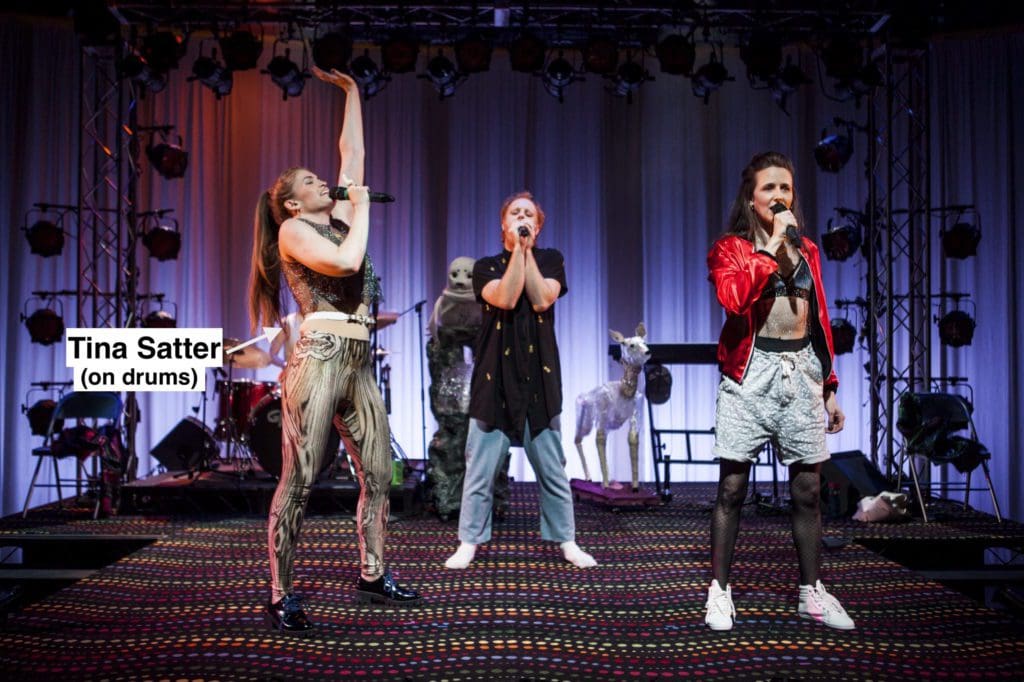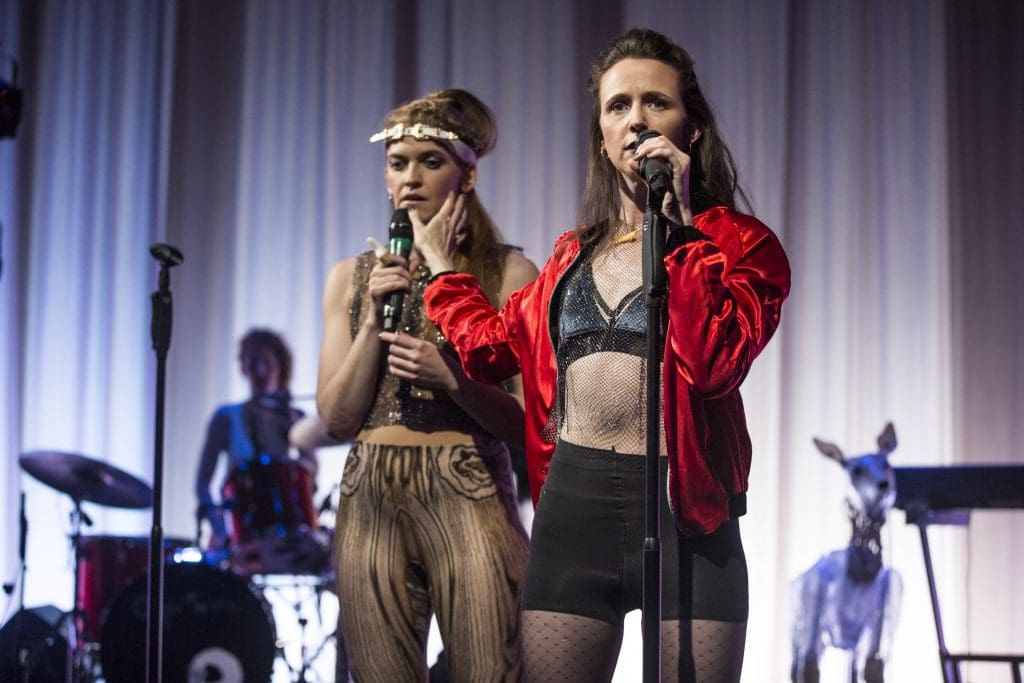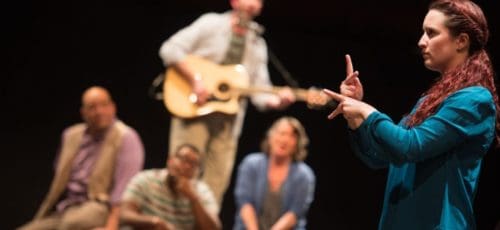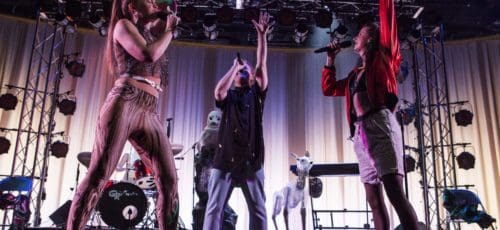The Making of Ghost Rings: Interview with Tina Satter
“There had to be a real patience and generosity on their part. But that kind respect and assuming the best intentions of all involved is always the key to a collaboration as full-on as this was.”
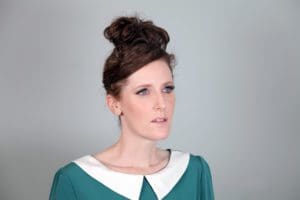 Tina Satter is the artistic director of the Obie-winning theater company Half Straddle. Her work has been described by The New York Times as a “vitalizing blend of coziness and estrangement, weirdness and familiarity.” Her new show, Ghost Rings, coming to the 2017 Fringe Festival, is no exception. Drawing from events of her own life, she uses the format and flow of a pop concert to create a work of theater. On stage the band is made up of two women singers, an additional musician, and Satter herself on drums. Also present are two puppet “Private Inner Beings,” Deer and Seal-y. As the two characters grow up, the show examines their intense relationship, and the oscillating dynamics within deep connections between two people. We had a conversation with Tina Satter about her inspiration for Ghost Rings and the process of putting it together.
Tina Satter is the artistic director of the Obie-winning theater company Half Straddle. Her work has been described by The New York Times as a “vitalizing blend of coziness and estrangement, weirdness and familiarity.” Her new show, Ghost Rings, coming to the 2017 Fringe Festival, is no exception. Drawing from events of her own life, she uses the format and flow of a pop concert to create a work of theater. On stage the band is made up of two women singers, an additional musician, and Satter herself on drums. Also present are two puppet “Private Inner Beings,” Deer and Seal-y. As the two characters grow up, the show examines their intense relationship, and the oscillating dynamics within deep connections between two people. We had a conversation with Tina Satter about her inspiration for Ghost Rings and the process of putting it together.
FringeArts: Do you remember how the title Ghost Rings came into being? Do you remember where you were?
Tina Satter: Yes, in 2011, I was at a three-day silent writing retreat in upstate New York facilitated by the incredible playwright Erik Ehn. It was through the Pataphysics Playwriting Workshops. I generated some writing there that I’d had no pre-plan for, and it was taking shape in its earliest forms as a conversation between two young women, I didn’t know yet if they were sisters or friends or romantic partners —and in this early writing they were discussing basic things like borrowing a sweater, but then also asking each other dark existential questions—and in that first writing I remember having this thought that there was this kind of candy these girls would eat—I imagined it as pale purple circles and I called the candy Ghost Rings. And then I must have left the retreat titling all that early writing, draft, whatever it was, Ghost Rings, because when we showed the earliest versions of it at CATCH in June 2012, the whole thing was then called Ghost Rings.
FringeArts: Can you discuss the basic creative and narrative starting point for the show?
Tina Satter: Well, I had this very early writing of these two girls discussing these banal and existential questions, and in this very early draft they also each had these inner animals—one girl had a deer who was their corresponding inner animal, and the other had a seal. But I wanted to play with the idea that these weren’t actually cute, cuddly animals—but that they were kind of crass, and direct, and not necessarily mean, but maybe didn’t always offer great advice, that they sort of actually operate like “mean girls” and that the deer in particular wanted to talk about sex and stuff.
FringeArts: How did the music develop?
Tina Satter: I had this early writing, and the Half Straddle composer, Chris Giarmo, and I had been discussing doing a project that really focused on singing. We always have original music, scores, and often songs in our shows—and usually these are performed by a mix of untrained and trained singers. Both Chris and I are excited about the quality of untrained singers and we had this great collaboration of my totally weird lyrics and bad music ideas being transferred into this singular, beautiful music by Chris that’s such an important component of our shows. So Chris had recently expressed at that point that he wanted to experiment with making music out of our collaboration that was more challenging and required very, very good singers to do it—and I loved that challenge and idea. And from the beginning, we’re like maybe it’s a fully sung-through piece? But not yet having any idea what that would mean for us—something more like Nature Theater of Oklahoma? Operatic? A rock show? The formal container was still very abstract. But we knew from the beginning we wanted to work with Erin Markey who has an incredible voice and stage presence, and we’d been collaborating with her for a while. Then we knew we needed another female to sing the other part, but hadn’t found her yet. So, in the earliest showings of excerpts, it would just be Chris and Erin performing, with Erin singing the part of a girl named Samantha and Chris singing the other girl’s lines.
And I knew of the actor Kristen Sieh, who’s outstanding but I didn’t know she was a singer, and sometime in 2012 I saw her in a show where she sang—and she suddenly seemed like the perfect person to play opposite Erin, so I started calling the other female character Kristen, but because of scheduling and other shows, we didn’t get to try the material with Kristen until March 2014 at a residency at the Performing Garage—and it worked! Kristen and Erin were very exciting together. And, in the early showings, we sometimes experimented with these private, inner-being animals as projections, which I always thought they would be, but when we weren’t able to projections at certain showings, I would manipulate these “puppets” which were literally a picture of a deer and seal taped to pencils. But from that idea, where I was indirectly in the showings shaking these pencil puppets, Chris Giarmo had the idea that I should somehow remain in the show, and learn an instrument to be in the band with them—so the idea that I would learn the drums began.
FringeArts: How did the animal companions evolve from that point?
Tina Satter: Once we got a commission from New York Live Arts and knew the show would premiere in April 2016, I had to get more specific about the design aspects and decided I didn’t want to render the animals as video. I had this idea they instead they should be life-size objects, and through figuring out how that could happen, I met with puppeteer Amanda Villalobos who slowly convinced me that they could be life-size puppets . . . I had some innate prejudice against puppets, but since they were being voiced by Kristen and Erin anyways, it ultimately made sense to have these amazing life-size deer and seal they manipulate and animate and voice, which, of course, are puppets.
Meanwhile, I was honing and refining the writing between these two characters then called Samantha and Kristen and their animals (Seal-y and Deer) and in the writing they had become these best friends who also have this deep romantic connection and as they grow, one truly wants to have a baby with the other and sets this intention that she is pregnant and it comes true! And at the same time I was going through all this stuff with my actual sister who I’d always been super close to—but there was pretty intense stuff she was going through and we were estranged, and I couldn’t help putting really direct and personal writing about my sister in the show, and then I was working on how to make those two distinct aspects of text work together. And then I remembered how when we were really little my sister and I had a “band” with a friend, a fake band obviously, but that for a moment in time we took it really seriously, and then this became the perfect through-line for Ghost Rings—to recreate a band now as an adult and artist in order to frame these memories and new stories, and since we’d wanted to make it a music show, it now really was, we were a band.
FringeArts: Can you discuss this format of Ghost Rings, the rock concert which is sort of like play but disguised as a rock concert, one that uses the energy of the live band experience to create emotion and connection, yet tells a story?
Tina Satter: Once I was truly “joining” the band onstage to play drums—this idea of a band as the performative framework was in motion—but we still had to figure out what that meant, what idiom were we playing with, etc. The songs were these special, singular, quite pop-py, and beautiful songs that could have gone in a number of forms—so I started looking at footage of bands, female bands, Riot Grrrl, etc., and there’s that incredible shared looseness of live rock—that’s at once totally synced and then totally, totally live aspect that felt exciting to be this container for this emotional throughline that was hard to nail down but very evocative within text and songs. And, then what did it mean if we kept sections dialogue and these big animal puppets within the music context? And, it kept making sense to make those work within a rock concert idea—that there are mic stands and a set highly designed but for a rock show, not some traditional theater set. And that since the show now contained these varied narratives—the romanticized friendship of the two girls, their pending queer parenthood, and then my stuff with my sister—all that could exist with way less pressure on it to tell a straightforward narrative if it existed in this song cycle format. Music engenders a feeling you can’t even name in your body, heart, and brain, and watching these people onstage not just create narratives and drama, but all this live melody really paired with the content of the show and our holistic approach to it from the earliest stages. And, Chris Giarmo, and Erin Markey, and Kristen Sieh are rock stars! I mean Erin really is that in so much of her own work and her cabaret context, and Kristen’s such a high-level actor and singer she’s a total rock star, and Chris Giarmo is a force like that in a range of projects from his work with Taylor Mac to Kimberly Clark, but they are not seen just as “rock stars” since we’re all so rooted in this avant-garde theater world, so to frame them like that coming out of our theater idiom was fun and exciting as well.
FringeArts: What musical sensibilities/contributions did Erin Markey and Chris Giarmo bring that made you want them to write music for Ghost Rings? And how did you communicate your own sensibilities?
Tina Satter: Chris Giarmo and I have worked together on every Half Straddle show since the first one in 2008. To me, from the very beginning, it’s been important that we have original music and score for every show—and to have Chris as the company composer to make that happen has been such a pleasure and gift. Although I’m drawn to music and applying music to performance, I’m completely unmusical, I’m just instinctual—so what’s been particularly special about the collaboration with Chris is that we start with lyrics. I have no sense of writing to verse, chord, or anything, but they are written as lyrics not just chunks of text, and then I usually have several ideas of actual songs that could influence how a given song for a show could sound— like “this song should sound kind of like this Dolly Parton song,” or “this aspect of a Kendrick Lamar song is cool” and then Chris takes my lyrics and those kind of abstract references to a given song and has carte blanche from there to adjust lyrics to work musically better, etc. It’s a generous exchange—and I think the resulting songs and music are special from that trust and his allowing my untrained but instinctual aesthetic to be there and inform the music. For Ghost Rings, I shared with Chris a range of music and musicians I was interested in for the show in general—way less of a song by song idea than usually we have.
And, then we wanted Erin from the beginning to be one of the two main singer/performers of the piece—and Erin has always made her own songs too for her work and was doing that even more, so at that point it was very natural for her to work with Chris to co-compose, to discover melodies and structure for a number of the songs. For the first showings of this piece, the three of us would rehearse in Chris’s bedroom where he had his keyboard, and they’d read through the script and make melodies and songs out of the dialogue, and then certain parts that were clear songs, they’d start to find the structure together. They’d be at the keyboard and I’d lie on Chris’s bed occasionally piping up with probably annoying music thoughts, but it was so real, it felt like high school or being in some scene in My So-Called Life. It was good.
Once they’d found some base aspects of the songs, Chris went away and honed the arrangements, and then ultimately the first weeks of rehearsal leading up to the full premiere in 2016 was Chris teaching Erin and Kristen the full songs, and Chris and Erin making adjustments as they worked. It was also such a treat to be in the room as these three singers at this level found harmonies and fleshed out the songs—I was at the drum kit!.
With Chris and Erin and our years of working together, we have a real shorthand and shared knowledge of what we’re interested in musically, aesthetically, humorwise, etc.—so when I say, for example, something should be “weirder” they both get that. We didn’t all always agree as they were figuring out parts of the music, but the intricacy and amount of music to make and learn for this show meant really learning to listen and share those thoughts in a super specific and respectful way. And then that they were going to make these really hard songs that had this beginner drummer in them definitely informed the sensibility and approach to the work and the songs ultimately. There had to be a real patience and generosity on their part. But that kind respect and assuming best intentions of all involved is always the key to a collaboration as full-on as this was—a note-by-note reckoning in some instances.
FringeArts: Can you talk about the ideas of pairing? Writing about you and your sister and then spinning that off into two characters who are lovers, as well as two personal animal daemons?
Tina Satter: It’s funny that as obvious as that concept is, I’ve never consider the idea of “pairing” in the show, but it’s kind of the whole thing! But, yeah, I started with the idea of the two girls as the very first narrative line, and in the very first iterations of the piece I hadn’t yet decided if they were sisters or not—and that was several years before I added in the explicit writing about my sister—so the sister concept was haunting it I guess. But, because I just have one sibling, one sister, and we grew up so close—that relationship, dynamic, and how we communicate does inform in varying levels everything I make. And as this show developed to encase both the romanticized girls and the thread of my sister and I, I was subconsciously exploring the idea the energy between pairs—like I was very interested in considering that kind of deep, deep romance that exists in totally non-sexual dynamics, like between sisters or two platonic friends. So, once I was exploring essentially the sadness, and amazing memories of a kind of lost “romance” with my sister, then it was then also cool to push the friendship narrative of the piece to a more sexualized romantic space, but in this very weird and holistic way that now with distance from the making of the show itself I can see weaves together a childhood version of romance; the true attempts at adolescent connection with another, both sexual and not; and then the actual real-life absurdity and beauty and devastation that exists almost minute to minute in attempting love and commitment between two people as an adult.
I also didn’t realize for a while, even though I had read and loved A Golden Compass, that I had straight up rendered a version of daemons in this. But I can’t point to a clear intellectual reason why I added those animals—these private inner beings—in that early writing. I guess for the obvious dramatic action of actualizing an inner version of one’s self. And the thing that was exciting the first day we rehearsed with rehearsal versions of the life-size puppets and the girls each held a microphone and would switch between their “Girl” voice and “Inner Being” voice—and they were doing the section where Deer is asking Seal-y about masturbation and Chris was doing this live accompaniment—and as the animals shyly awkwardly moved, led by the girls’ hands and talked in this weird animal voice on mic, suddenly, we were like, this is it! These weird DIY animals are exactly what the girls should would make to really say things to each other. Having them rendered as these weird art animals speaking through microphones felt really punk and female and so much of the essence of the piece we were trying to dig to.
FringeArts: What did you work on most in fine-tuning this show?
Tina Satter: The first most obvious fine-tuning was that I needed to learn how to play the drums! What I do in the show is still very rudimentary drumming, but even that was a huge step for me and takes lots of practice and prep each time we do the show again. Then, I adjusted the text a bit between the premiere in April 2016 and the run at the American Realness Festival in January 2017. We’ll probably implement a few small staging changes from what we learned in January and to adjust to any space changes in the venue at Fringe Arts. Then the level of singing that Kristen, Erin, and Chris do always needs to be worked on and maintained both for their comfort in performing the songs at the level they want and in feeling comfortable with monitor levels and sound in each given space we perform—so that always is definitely the overall priority for this show since it’s 90% singing, that those three feel best prepared and equipped to perform in the way they want.
Ghost Rings
Half Straddle
Sept 8 at 8pm
Sept 9 at 8pm*
*Features American Sign Language interpretation by Hands Up Productions.
Painted Bride Art Center
230 Vine Street
Wheelchair accessible
$29 (general)
20.30 (member)
$15 (student + 25-and-under)
TICKETS + INFO
Interview by Josh McIlvain, May 2017. Additional text by Isabella Siegel. Show photos by Maria Baranova.

